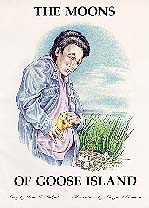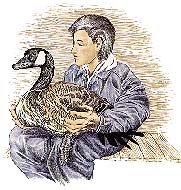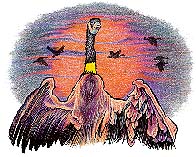


|
The Moons of Goose Island.
Don K. Philpot. Illustrations by Margaret Hessian.
Subject Headings:
Grades 1 - 6 / Ages 6 - 11. ** /4
|

excerpt:
That night grandpa made a baby-sized bed for the newborn by mine. "He may cry out for his mother," grandpa warned; "talk to him. You are his only family now."So that night I told the gosling the story of how I came to live on Goose Island.
 The Moons of Goose Island, a story set in an aboriginal
family, deals with a young boy overcoming his grief after his
mother's death. When David, the youngster, goes to live with his
grandparents on Goose Island, they assure him that one day he will
meet his mother again. Not only must David cope with the loss of
his mother, but he must learn to accommodate himself to his new
surroundings. Grandma tells David that the moons of Goose Island are
unlike the moons anywhere else on earth, and the book takes David and
the reader through The Moon of the Returning Geese, The Leafing Moon,
The Planting Moon, Summer Moon and Autumn Moon. David's moon,
though, is the Moon of the Weeping Heart, as he remembers his mother.
His attention is diverted when he finds an orphaned gosling. David
becomes its surrogate parent and experiences the joy and annoyances
of raising it throughout the summer. When fall comes, David
must let the now full-grown goose follow its instincts and migrate.
Although Diver, the goose, returns in the spring, he is wild and
stays only a moment to show David that he is mature and independent.
Initially disappointed, David realizes that his former friend is just
following a natural process. David is again reminded of his mother,
but the remembrance is now pleasant because he sees her in The Moon
of the Journey Home. David accepts the natural process of living and
dying and understands his grandmother's assurance that the moons of
Goose Island are unlike any others on earth and that they were
pivotal in his working his way through his grief. Young readers who
experience the loss of a close family member may identify with
David's grief and come to understand that the healing process is
sometimes long and painful. Like David, they must come to understand
that death is a natural part of life, but that the living can be
filled with the joy of remembering after the pain of the loss
disappears. Philpot has captured that lesson in this book. Longer
than a typical picture book, the story could have been edited.
However, the book can be used to discuss the stages of growth and
development of nature, the bird and the boy.
The Moons of Goose Island, a story set in an aboriginal
family, deals with a young boy overcoming his grief after his
mother's death. When David, the youngster, goes to live with his
grandparents on Goose Island, they assure him that one day he will
meet his mother again. Not only must David cope with the loss of
his mother, but he must learn to accommodate himself to his new
surroundings. Grandma tells David that the moons of Goose Island are
unlike the moons anywhere else on earth, and the book takes David and
the reader through The Moon of the Returning Geese, The Leafing Moon,
The Planting Moon, Summer Moon and Autumn Moon. David's moon,
though, is the Moon of the Weeping Heart, as he remembers his mother.
His attention is diverted when he finds an orphaned gosling. David
becomes its surrogate parent and experiences the joy and annoyances
of raising it throughout the summer. When fall comes, David
must let the now full-grown goose follow its instincts and migrate.
Although Diver, the goose, returns in the spring, he is wild and
stays only a moment to show David that he is mature and independent.
Initially disappointed, David realizes that his former friend is just
following a natural process. David is again reminded of his mother,
but the remembrance is now pleasant because he sees her in The Moon
of the Journey Home. David accepts the natural process of living and
dying and understands his grandmother's assurance that the moons of
Goose Island are unlike any others on earth and that they were
pivotal in his working his way through his grief. Young readers who
experience the loss of a close family member may identify with
David's grief and come to understand that the healing process is
sometimes long and painful. Like David, they must come to understand
that death is a natural part of life, but that the living can be
filled with the joy of remembering after the pain of the loss
disappears. Philpot has captured that lesson in this book. Longer
than a typical picture book, the story could have been edited.
However, the book can be used to discuss the stages of growth and
development of nature, the bird and the boy.

The illustrations are both black ink and pencil crayon, with colour being added as "colour" returns to David's outlook on life. Though the illustrations are well done, it is hard to determine David's age because, in some pictures, he looks older than in others.
This book would be of value in a school library, for aboriginal children and for children who have experienced a personal loss.
Recommended.
Harriet Zaidman is a teacher-librarian in Winnipeg.

To comment on this title or this review, send mail to cm@umanitoba.ca.
Copyright © 1997 the Manitoba Library Association. Reproduction for personal use is permitted only if this copyright notice is maintained. Any other reproduction is prohibited without permission.
Published by
The Manitoba Library Association
ISSN 1201-9364
TABLE OF CONTENTS FOR THIS ISSUE - JUNE 6, 1997.
AUTHORS | TITLES | MEDIA REVIEWS | BOOKSHELF | BACK ISSUES | SEARCH | HOME